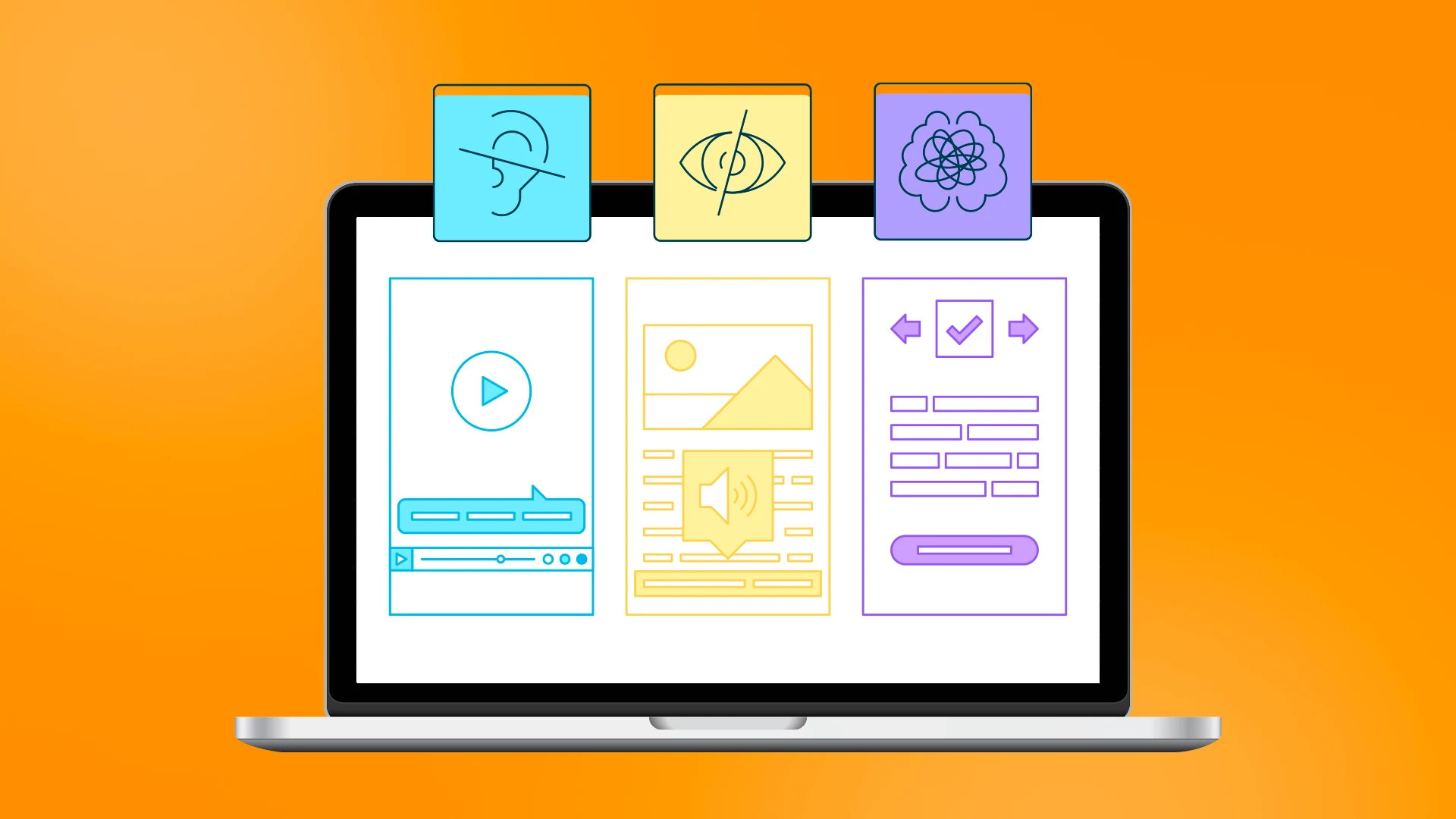Do you know what digital accessibility is? Understand the importance of providing accessible digital tools.
More than one billion people worldwide have some form of disability. To ensure that everyone has easier access to products and services on the internet, it is essential to invest in digital accessibility by creating effective tools so that this audience is not excluded from the digital universe.
What is digital accessibility?
The term digital accessibility refers to the practice of making digital products, services, content, and technologies accessible and usable by all people, including those with disabilities or functional limitations. This involves the development of efficient digital platforms so that everyone can interact, consume information, and perform tasks effectively, regardless of their physical, sensory, or cognitive abilities.
It’s worth noting that digital accessibility is not limited to people with permanent disabilities but also includes those with temporary disabilities, reduced mobility, elderly individuals, and anyone else who may encounter barriers when using digital technologies. The goal is to promote inclusion and equal access, allowing everyone to enjoy the benefits offered by the digital world.
This involves the implementation of inclusive design practices and guidelines, such as creating intuitive interfaces, choosing appropriate colors, providing textual alternatives for images, adding captions to videos, and ensuring compatibility with screen readers, among other considerations.
Digital accessibility also encompasses the adaptation of devices and software to accommodate different needs, such as alternative keyboards, voice commands, and other assistive technologies (AT).
Ultimately, digital accessibility is essential to ensure that the digital evolution benefits everyone, regardless of their abilities, and to build a more inclusive and equitable society in the online environment.
The principles of digital accessibility
The principles of digital accessibility, known as the “POB Principles” or “POUR,” are fundamental guidelines that steer the design and development of accessible digital products, services, and content. These principles aim to ensure that people with disabilities or functional limitations can interact with technologies. The three principles are:
Understandable
This principle focuses on making information and interface components perceivable to users’ senses. This involves ensuring that content is perceptible by people with different sensory abilities. Some aspects related to this principle include:
- Textual alternatives: providing alternative descriptions for images, graphics, and non-textual elements so that users with visual impairments can understand the context.
- Captions and transcripts: including captions in videos for individuals with hearing impairments and transcripts to facilitate content comprehension.
- Adequate contrast: using color combinations with sufficient contrast to ensure that text and visual elements are legible for everyone.
- Text size adaptability: allowing users to increase or decrease text size as needed.
Operable
This principle concerns how easily users can interact with interactive elements of the interface. The concept aims to ensure that all individuals, regardless of their motor or cognitive abilities, can navigate and operate digital systems. Some related factors include:
- Navigability: ensuring that navigation is intuitive and predictable, allowing users to move easily through the content.
- Adequate Time: providing users with enough time to read and interact with the content without time limitations being imposed.
- Keyboard Accessibility: ensuring that all functionalities can be accessed using just a keyboard to accommodate individuals with motor disabilities.
Robust
This principle involves keeping digital technologies effective and functional across various platforms, browsers, and devices, aiming to ensure that digital content remains durable and consistent in different technological contexts over time. The concept encompasses points such as:
- Compatibility: ensuring that digital products work in various environments, including different browsers, operating systems, and devices.
- Current and Future Technologies: using web standards and technologies that are up-to-date and have the potential to be supported in future technologies.
It is worth reinforcing that these principles are fundamental to ensuring the creation of inclusive digital experiences, allowing anyone to use and interact with digital resources effectively.
Understanding assistive technologies
Assistive technologies are tools, devices, software, and equipment designed to assist people with disabilities in overcoming barriers and performing activities that would otherwise be challenging or impossible. These technologies aim to promote independence, inclusion, and quality of life for individuals with various types of functional limitations. Here are some examples of assistive technologies:
Screen Readers: These are software programs that convert on-screen content into synthesized text or audio. This technology is essential for individuals with visual impairments, allowing them to access information on computers, smartphones, and other devices.
Screen Magnifiers: These are tools that enlarge the size of on-screen content, making it easier to read for individuals with reduced or low visual acuity.
Alternative and Augmentative Communication (AAC) Devices: These are used by individuals who have speech difficulties. These devices include symbol communication systems, communication boards, computer-based speech software, and communication apps.
Access Control Devices: These allow individuals with limited mobility to control electronic devices using alternative methods, such as joystick controls, eye-tracking devices, or voice commands.
Voice Recognition Technologies: These are used by individuals who have difficulty typing due to motor impairments. These technologies convert speech into text or execute voice commands.
Advanced Prosthetics and Orthotics: These include computer-controlled prosthetic limbs that enable users to perform complex movements, as well as motorized orthotic devices that assist with the movement of impaired joints.
Technologies for Hearing Impairments: There are hearing aids, cochlear implants, and visual alert systems that assist individuals with hearing impairments in communication and interaction.
Assisted Navigation Systems: These use GPS technology and location information to help individuals with visual impairments travel more safely, providing verbal and tactile directions.
Text Prediction and Auto-Correction Software: These assist individuals with writing difficulties and cognitive impairments by offering word suggestions and automatic corrections while typing.
Web Accessibility Technologies: Features such as video captions, textual alternatives for images, and responsive designs that adapt to different devices and screen sizes.
It is important to emphasize that assistive technologies are highly personalized, adapting to the specific needs of each individual. Furthermore, they are constantly evolving, leveraging technological advancements to provide increasingly effective and inclusive solutions.
Tips for creating a more inclusive project
Some key tips are essential for creating more inclusive digital projects that cater to all users, including those with disabilities or functional limitations:
Highlight Content: Ensure that the most important and relevant content is well-highlighted in the interface. This helps users quickly identify essential information, making navigation easier.
Do Not Rely on Colors for Conveying Information: Avoid conveying critical information solely through colors, as individuals with visual impairments or color blindness may have difficulty perceiving color nuances and differences.
Provide Various Navigation Options: Offer diverse ways to navigate through the content, such as navigation menus, search bars, and internal links. This helps users find what they’re looking for regardless of their navigation abilities.
Develop with Compatibility in Mind: Ensure that your project functions well on a variety of devices, browsers, and platforms. This includes mobile devices, desktops, screen readers, and assistive technologies.
Structure Texts Accessibly: Use headings, subheadings, and paragraphs to organize content clearly. Use a legible font and adjustable text size to accommodate different reading preferences and needs.
Provide Textual Alternatives for Images: Always include alternative descriptions for images, graphics, and visual elements. This is essential for individuals with visual impairments who use screen readers.
Create an Intuitive User Experience: Prioritize simplicity and clarity in the interface. Make navigation easy, avoid complex jargon, and provide clear instructions for all actions.
Bonus: Tips for Websites
In addition to all the tips mentioned above for creating inclusive projects, some more specific tools are essential for the development of inclusive websites:
Use Semantic and Well-Structured HTML: By using HTML tags semantically, you are helping create a clear and meaningful structure for content. This benefits users, especially those using screen readers, allowing them to understand the hierarchy and purpose of elements on the page.
Use the ALT Attribute for Images: The “ALT” attribute provides a textual description for images. This is essential for people using screen readers, as it allows them to understand the content of images they cannot see.
Don’t Disable User Zoom: Avoid setting fixed font sizes or layouts that prevent users from zooming in or out on the page. This is especially important for individuals with visual impairments who need to adjust text size for reading.
Pay Attention to Tabindex and Allow Skipping Menus: The “tabindex” attribute determines the order in which elements are accessed using the Tab key. Ensure that the order is logical and consistent. Additionally, allow users to skip directly to the main content, bypassing repetitive menus, using techniques like “skip links.”
Use Captions for Videos: Add captions to all videos to make them accessible to people with hearing impairments. This allows them to understand the content through text, even if they cannot hear the audio.
Ensure Adequate Contrast: Choose color combinations that offer sufficient contrast between text and background. This improves readability for all individuals, including those with reduced vision.
Provide Non-Text Media Alternatives: In addition to captions for videos, offer audio descriptions of images for individuals with visual impairments. This enables them to understand the elements present in your content.
Develop Accessibility from the Beginning: Including accessibility from the outset of the development process is more efficient than trying to fix issues later. It also helps incorporate accessibility as a natural part of the creative process.
Remember that creating a more inclusive project, including a website, is not only an ethical obligation but also a smart strategy as it expands your audience’s reach and enhances the experience for all users. Let’s do this!





